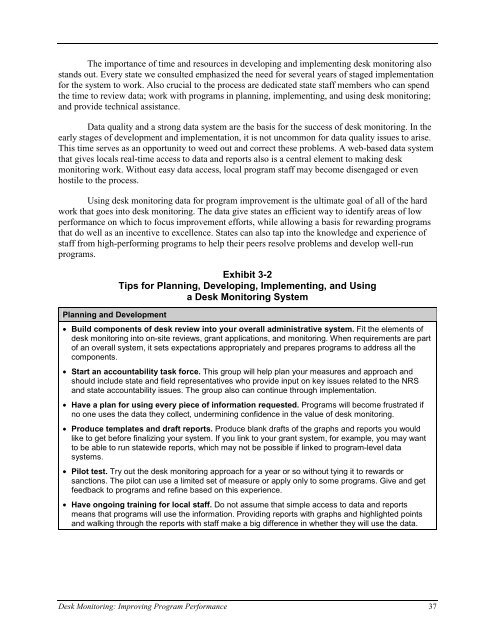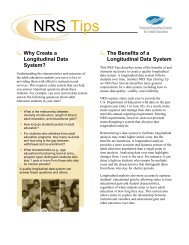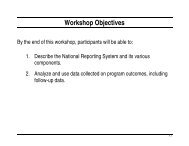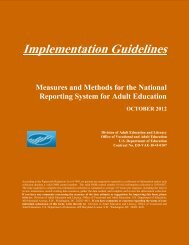Desk Monitoring Guide - National Reporting System
Desk Monitoring Guide - National Reporting System
Desk Monitoring Guide - National Reporting System
Create successful ePaper yourself
Turn your PDF publications into a flip-book with our unique Google optimized e-Paper software.
The importance of time and resources in developing and implementing desk monitoring alsostands out. Every state we consulted emphasized the need for several years of staged implementationfor the system to work. Also crucial to the process are dedicated state staff members who can spendthe time to review data; work with programs in planning, implementing, and using desk monitoring;and provide technical assistance.Data quality and a strong data system are the basis for the success of desk monitoring. In theearly stages of development and implementation, it is not uncommon for data quality issues to arise.This time serves as an opportunity to weed out and correct these problems. A web-based data systemthat gives locals real-time access to data and reports also is a central element to making deskmonitoring work. Without easy data access, local program staff may become disengaged or evenhostile to the process.Using desk monitoring data for program improvement is the ultimate goal of all of the hardwork that goes into desk monitoring. The data give states an efficient way to identify areas of lowperformance on which to focus improvement efforts, while allowing a basis for rewarding programsthat do well as an incentive to excellence. States can also tap into the knowledge and experience ofstaff from high-performing programs to help their peers resolve problems and develop well-runprograms.Planning and DevelopmentExhibit 3-2Tips for Planning, Developing, Implementing, and Usinga <strong>Desk</strong> <strong>Monitoring</strong> <strong>System</strong>• Build components of desk review into your overall administrative system. Fit the elements ofdesk monitoring into on-site reviews, grant applications, and monitoring. When requirements are partof an overall system, it sets expectations appropriately and prepares programs to address all thecomponents.• Start an accountability task force. This group will help plan your measures and approach andshould include state and field representatives who provide input on key issues related to the NRSand state accountability issues. The group also can continue through implementation.• Have a plan for using every piece of information requested. Programs will become frustrated ifno one uses the data they collect, undermining confidence in the value of desk monitoring.• Produce templates and draft reports. Produce blank drafts of the graphs and reports you wouldlike to get before finalizing your system. If you link to your grant system, for example, you may wantto be able to run statewide reports, which may not be possible if linked to program-level datasystems.• Pilot test. Try out the desk monitoring approach for a year or so without tying it to rewards orsanctions. The pilot can use a limited set of measure or apply only to some programs. Give and getfeedback to programs and refine based on this experience.• Have ongoing training for local staff. Do not assume that simple access to data and reportsmeans that programs will use the information. Providing reports with graphs and highlighted pointsand walking through the reports with staff make a big difference in whether they will use the data.<strong>Desk</strong> <strong>Monitoring</strong>: Improving Program Performance 37









